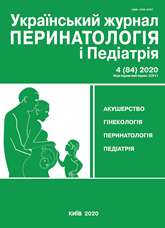Apert syndrom: a literature review and own clinical case
DOI:
https://doi.org/10.15574/PP.2020.84.55Keywords:
Apert syndrome, children, prenatal diagnosisAbstract
Acrocephalosyndactyly (ACS) is a group of multiple malformations, the main clinical manifestations of which are acrocephaly and syndactyly. The most common forms are Apert (type I), Pfeiffer (type V), Setra–Hotzen (type II) syndromes. Apert syndrome is the most explored and common form of all types of ACS and Apert syndrome is estimated to occur in 1 in: 100 000 newborns. The syndrome is inherited in an autosomal dominant manner. If the gene is carried by one of the parents, the risk of having a child with Apert syndrome is 50%. The syndrome genome (FGFR2) is located on the long arm of chromosome 10 at locus 10q26. Apert syndrome occurs due to mutations at this locus, but the children karyotype is not changed. The pathognomonic clinical signs of Apert syndrome are craniofacial dysostosis and symmetrical syndactyly of the hands and feet. Acrocephaly («tower skull») — is a consequence of early synostosis of some sutures of the skull. Orbital hypertelorism and exophthalmos are referred to typical facial changes. Among other abnormalities there are heart and vascular defects (25%), cleft palate, malformations of the gastrointestinal tract and kidneys. The diagnosis is made on the basis of clinical symptoms. No treatment has been developed. Life expectancy is short.
Purpose — to present a clinical case of a newborn with Apert syndrome.
Clinical case. Apert syndrome was suspected prenatally, confirmed after birth. The newborn girl had the characteristic signs of the above-described pathology: «tower head», hypertelorism, saddle bridge of the nose, closed large fontanelle, phalanges of the first finger were wide, the proximal phalanx was triangular, complete cutaneous syndactyly of the II–IV fingers was observed symmetrical on both upper extremities; on the lower extremities — thickening of the proximal phalanges of the big toes, complete cutaneous syndactyly of the II–IV toes.
Conclusions. The article describes a clinical case of a child with Apert syndrome. Prenatal diagnosis takes one of the leading places in confirming genetic abnormalities, determining the prognosis for life. Genetic counseling for parents is necessary and important at all stages of pregnancy planning.
The research was carried out in accordance with the principles of the Helsinki Declaration. The study protocol was approved by the Local Ethics Committee of these Institutes. The informed consent of the patient was obtained for conducting the studies.
No conflict of interest was declared by the authors.
References
Apert ME. (1906). De l'acrocephalosyndactylie. Bull. Mem. Soc Med Hop Paris. 23: 1310–1330.
Chirkova GN, Sorokina TV, Novikov NV. (2003). Two cases of acrocephalosyndactyly. Pediatrics. 5: 1–4.
Conrady CD, Patel BC, Sharma S. Apert Syndrome (2020). StatPearls: 1–10.
Gernet S Von, Golla A, Ehrenfels Y, Schuffenhauer S, Fairley Jd (2000). Genotype-phenotype analysis in Apert syndrome suggests opposite effects of the two recurrent mutations on syndactyly and outcome of craniofacial surgery. Clinical genetics. 57 (2): 137-139. https://doi.org/10.1034/j.1399-0004.2000.570208.x; PMid:10735635
Kozlova SI, Demikova NS, Semanova E, Blinnikova OE. (1996). Hereditary syndromes and medical genetic counseling. 2nd ed. Moscow: 416.
Mathijssen IM. (2015). Guideline for Care of Patients With the Diagnoses of Craniosynostosis: Working Group on Craniosynostosis. J Craniofac Surg. 26 (6): 1735-1807. https://doi.org/10.1097/SCS.0000000000002016; PMid:26355968 PMCid:PMC4568904
Tara L Wenger, Anne V Hing, Kelly N Evans. (2019). Apert Syndrome Synonym: Acrocephalosyndactyly Type I. GeneReviews: 1-29. URL: https://pubmed.ncbi.nlm.nih.gov/31145570.
Tolarova MM, Harris JA, Ordway DE, Vargervik K. (1997). Birth prevalence, mutation rate, sex ratio, parents' age, and ethnicity in Apert syndrome. Am J Med Genet. 72: 394-398. https://doi.org/10.1002/(SICI)1096-8628(19971112)72:4<394::AID-AJMG4>3.0.CO;2-R
Torres L, Hernandez G, Barrera A, Ospina S, Prada R. (2015). Molecular analysis of exons 8, 9 and 10 of the fibroblast growth factor receptor 2 (FGFR2) gene in two families with index cases of Apert syndrome. Colomb Med (Cali). 46: 150-153. https://doi.org/10.25100/cm.v46i3.1868; PMid:26600631
Yasonov SA, Lopatin AV, Maslov VV, Vasiliev IG, Bystrov AV. (2011). Aper's Syndrome (Apert): modern possibilities of complex reconstructive treatment Children's Hospital. 2: 51–54.
Downloads
Published
Issue
Section
License
The policy of the Journal “Ukrainian Journal of Perinatology and Pediatrics” is compatible with the vast majority of funders' of open access and self-archiving policies. The journal provides immediate open access route being convinced that everyone – not only scientists - can benefit from research results, and publishes articles exclusively under open access distribution, with a Creative Commons Attribution-Noncommercial 4.0 international license(СС BY-NC).
Authors transfer the copyright to the Journal “MODERN PEDIATRICS. UKRAINE” when the manuscript is accepted for publication. Authors declare that this manuscript has not been published nor is under simultaneous consideration for publication elsewhere. After publication, the articles become freely available on-line to the public.
Readers have the right to use, distribute, and reproduce articles in any medium, provided the articles and the journal are properly cited.
The use of published materials for commercial purposes is strongly prohibited.

